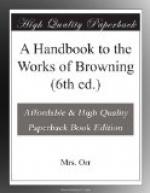“You were mine. Now I give myself to you.” (vol. vii. p. 28.)
“THE RING AND THE BOOK.” 1868-69.
From the dramas, we pass naturally to the dramatic monologues; poems embodying a lengthened argument or soliloquy, and to which there is already an approach in the tragedies themselves. The dramatic monologue repeats itself in the finest poems of the “Men and Women,” and “Dramatis Personae;” and Mr. Browning’s constructive power thus remains, as it were, diffused, till it culminates again in “The Ring and the Book:” at once his greatest constructive achievement, and the triumph of the monologue form. From this time onwards, the monologue will be his prevailing mode of expression, but each will often form an independent work. “The Ring and the Book” is thus our next object of interest.
Mr. Browning was strolling one day through a square in Florence, the Piazza San Lorenzo, which is a standing market for old clothes, old furniture, and old curiosities of every kind, when a parchment-covered book attracted his eye, from amidst the artistic or nondescript rubbish of one of the stalls. It was the record of a murder which had taken place in Rome, and bore inside it an inscription which Mr. Browning thus transcribes:—
“...
A Roman murder-case:
Position
of the entire criminal cause
Of Guido
Franceschini, nobleman,
With certain
Four the cut-throats in his pay,
Tried, all
five, and found guilty and put to death
By heading
or hanging as befitted ranks,
At Rome
on February Twenty-Two,
Since our
salvation Sixteen Ninety-Eight:
Wherein
it is disputed if, and when,
Husbands
may kill adulterous wives, yet ’scape
The customary
forfeit.” (vol. viii. p. 6.)
The book proved, on examination, to contain the whole history of the case, as carried on in writing, after the fashion of those days: pleadings and counter-pleadings, the depositions of defendants and witnesses; manuscript letters announcing the execution of the murderer; and the “instrument of the Definitive Sentence” which established the perfect innocence of the murdered wife: these various documents having been collected and bound together by some person interested in the trial, possibly the very Cencini, friend of the Franceschini family, to whom the manuscript letters are addressed. Mr. Browning bought the whole for the value of eightpence, and it became the raw material of what appeared four years later as “The Ring and the Book.”




